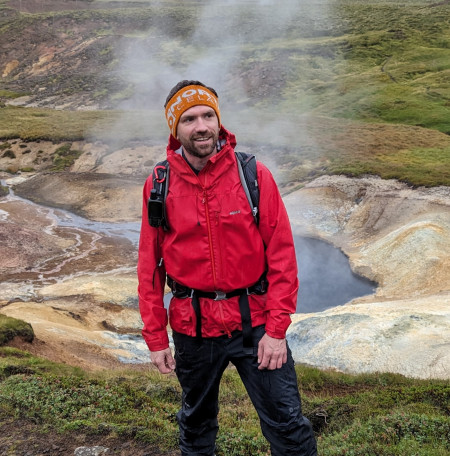
Dr Mark Fox-Powell
Senior Lecturer
School of Environment, Earth & Ecosystem Sciences
Biography
Professional biography
2023- present: Senior Lecturer, AstrobiologyOU, School of Environment, Earth and Ecosystem Sciences, Open University
2023: Senior Research Fellow, AstrobiologyOU, Open University
2020-2023: Research Fellow, AstrobiologyOU, Open University
2016-2019: Postdoctoral Research Fellow, School of Earth and Environmental Sciences, University of St Andrews
2016: Research Assistant, School of Earth and Environmental Sciences, University of St Andrews
2012-2016: PhD in Astrobiology, School of Physics and Astronomy, University of Edinburgh
Research interests
My research interests centre around icy worlds in our Solar System that contain liquid water under their surfaces. These so-called 'ocean worlds' that include Jupiter's moons Europa and Ganymede, Saturn's moons Titan and Enceladus, and dwarf planets such as Ceres, may contain conditions suitable for life in the present day. I focus on how ice and salts delivered to the surfaces of these worlds by processes such as 'cryovolcanism' can be used to learn about the oceans far below.
Work in my team involves laboratory experiments and fieldwork to icy world analogue locations in Earth's high latitudes. We seek to understand how ocean chemistry and evidence of life might become delivered to and preserved at the surfaces of icy worlds. A major focus is on how the physical conditions in cryovolcanic eruptions (such as the extreme changes in temperature and pressure in the plumes of Enceladus) affects the erupted material.
In the lab, we develop and employ novel cryo-analytical techniques to understand icy world materials at the molecular and micro-scale, and use planetary simulation facilities to relate our findings to the icy surfaces of ocean worlds. In the field, we study ice, brines and aerosols ejected from the subsurface in polar and sub-polar environments, including in Iceland, Svalbard and the Canadian High Arctic. Our findings help interpret existing data from missions such as Galileo and Cassini, and support upcoming missions such as the JUpiter Icy Moons Explorer (ESA) and the Europa Clipper (NASA).
Recent research highlights
1. My team has discovered a new type of salt crystal, made from sodium chloride and water molecules, that forms during rapid 'flash' freezing of brines. This is only the third new form of sodium chloride to be described in over 200 years. In a recent paper led by OU postdoctoral researcher Dr Rachael Hamp, we describe the structure of this material and how it relates to other known forms of sodium chloride. If detected by upcoming missions at icy worlds it would indicate regions where liquid from below has been rapidly delivered to the surface by active process such as plumes.
2. We have developed new experimental and analytical techniques to study on the microscale how salty fluids behave as they freeze. We have used these approaches to identify the likely composition of ice grains emmitted in the plumes of Enceladus, and track how evidence of life might be captured or preserved within them.
3. I have identifed Europa 'analogue' locations in the Canadian High Arctic, where supercold brines seep out to the surface, and form salts with similar chemical composition to those observed at Europa. This work has led to an extended research programme, with a range of talented UK and international colleagues, tracking how chemical and molecular traces of microbial life are preserved within the salts. This work helps to build the rationale for future missions that aim to directly seek evidence of life at icy worlds.
4. Working with an international team, we explored how liquid brines could be distributed vertically within Europa’s ice shell, and showed how this distribution affects the prospects for life within the ice. This work helps us to predict the depth at which habitable environments may be found in the present day, and has implications for protecting Europa from any Earthly contamination we might inadvertently bring on future spacecraft.
Publications
Journal Article
Microstructure Controls Sublimation Timescales of Exposed Salt‐Rich Ices on Icy Worlds (2025)
Accreted volatiles influence low-temperature rock equilibria on Europa (2025)
Biological nitrogen cycling within terrestrial hot springs: A Mars analogue system (2025)
A Potential Mushy Source for the Geysers of Enceladus and Other Icy Satellites (2025)
Microclimate governs the morphology of sediment flows on Mars (2025)
Is there H2O stacking disordered ice I in the Solar System? (2024)
Metastable Dihydrate of Sodium Chloride at Ambient Pressure (2024)
Iron reduction as a viable metabolic pathway in Enceladus' ocean (2023)
Brine Volume Fraction as a Habitability Metric for Europa's Ice Shell (2022)
Compositional Controls on the Distribution of Brine in Europa’s Ice Shell (2022)
Sulfur Cycling as a Viable Metabolism under Simulated Noachian/Hesperian Chemistries (2022)
Sulfur isotopes as biosignatures for Mars and Europa exploration (2022)
Hunting for Life on Mars by Studying Life on Earth (2021)
Quadruple sulfur isotope biosignatures from terrestrial Mars analogue systems (2021)
Volcanic controls on the microbial habitability of Mars‐analogue hydrothermal environments (2021)
Natural Analogue Constraints on Europa's Non-ice surface Material (2019)
An Ionic Limit to Life in the Deep Subsurface (2019)
Cryogenic silicification of microorganisms in hydrothermal fluids (2018)
Ionic strength is a barrier to the habitability of Mars (2016)
Presentation / Conference
Composition and Habitability of Europa’s Ocean Over Time (2024)
Microstructure controls longevity of exposed salt-rich ices on icy worlds (2024)
Composition and Habitability of Europa’s Ocean Over Time (2024)
Composition and Habitability of Europa’s Ocean Through Time (2023)
Modelling possible chemical evolution pathways during freezing of Europa’s ice shell (2023)
Modelling water-rock interactions in the subsurface environment of Enceladus (2021)
Brine evolution and transport-driven fractionation of ocean fluids within Europa’s icy shell (2021)
Colour Peak:An analogue environment for the waters of late Noachian Mars (2020)
Colour Peak: An analogue environment for late Noachian Mars (2020)